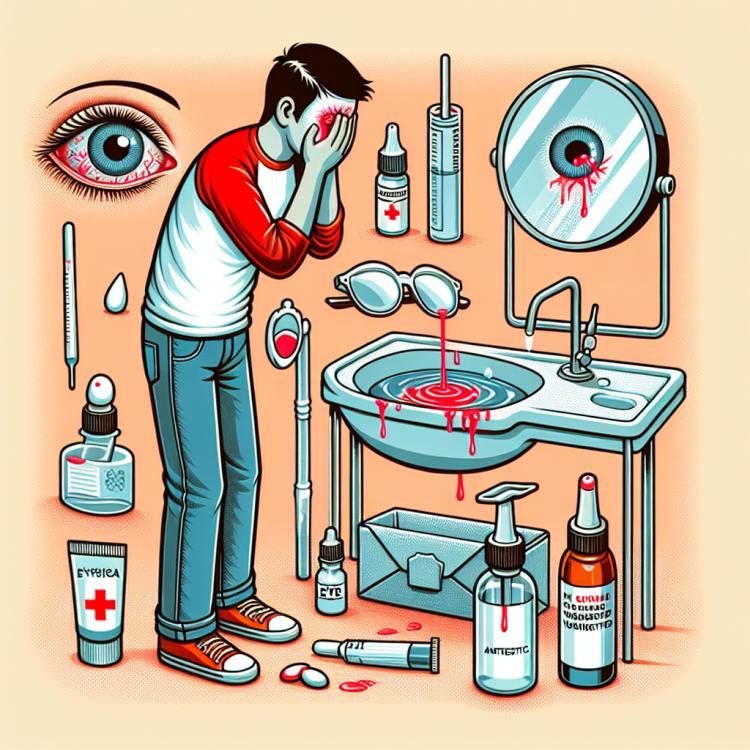
Eye burn: diagnosis, complications, and prevention
Understanding eye burns: symptoms, causes, and treatment
Eye burn is a serious injury that can lead to diseases and loss of vision. Symptoms of an eye burn may include pain, redness, swelling, and vision impairment. Immediate medical attention and appropriate treatment are crucial to prevent complications and preserve visual functions.
Factors that cause eye burns
Eye burns can be caused by various factors, including exposure to chemicals, heat, radiation, or infections. Chemical eye burns may result from contact with irritating substances such as acids, alkalis, or other aggressive chemicals. Thermal eye burns typically occur due to exposure to high temperatures, for example, when steam, molten metal, or flames come into contact with the eyes. Sunburn on the eyes is also possible with prolonged exposure to the sun without protective glasses or headgear.
- Chemical substances: Contact with aggressive chemicals such as acids and alkalis can cause burns to the eyes.
- Heat: High temperatures, for example, from contact with steam, flames, or hot liquids, can cause thermal burns to the eyes.
- Sun rays: Prolonged exposure to ultraviolet radiation without protection can lead to eye burns and corneal damage.
- Radiation: Radiation such as laser radiation or X-rays can cause burns to the eye tissue.
- Dust and particles: The entry of dust, sand, and other small particles into the eye can lead to irritation and burning of the conjunctiva.
Signs of eye burn
Eye burns manifest with various symptoms, including inflammation, redness, swelling, pain, and a burning sensation in the eyes. Patients may experience severe itching, tearing, as well as a feeling of foreign bodies or sand in the eyes. In some cases, a burn can lead to tissue destruction of the eye, changes in vision, or even vision loss, requiring immediate medical assistance and specialist treatment.
- Inflammation of the eye tissues: a burn to the eye can cause inflammatory reactions, manifesting as redness and swelling of the eye tissues.
- Sensation of burning and pain: the affected person may experience sharp pain and a burning sensation in the eye area, indicating the presence of a burn.
- Tearing and acute irritation: an eye burn can lead to increased tearing, as well as a feeling of irritation and itching.
- Reduced visual functions: in the case of an eye burn, the patient may experience changes in vision, such as blurriness, redness, or even loss of vision.
- Sensation of foreign bodies: the affected individuals may feel as if there are foreign bodies or grains of sand in their eyes, even if there are none, due to the reaction to the burn.
Expert opinion on methods of treating eye burns
The experts’ perspective on eye burn treatment methods is crucial in developing an effective intervention strategy. Specialists in ophthalmology and burn treatment emphasize the importance of early treatment initiation to minimize complications and preserve visual functions. The main approaches to treating eye burns include the use of local anesthetics, antibiotics to prevent infection, and anti-inflammatory medications, as well as potential surgical intervention in cases of severe eye injury. Specialized procedures for restoring burn damage to the eye may include tissue transplantation, corneal reconstruction, and visual function rehabilitation.

Diagnosis of eye burn
The diagnosis of eye burn is a comprehensive process that includes examining the eyes, measuring vision, assessing the degree of damage to eye tissues, and checking the pupils’ reaction to light. The doctor may use special tools, such as a magnifying glass or fluorescein dye, to study the eye damage in more detail. Additional diagnostic methods, such as gonioscopy, computed tomography, or magnetic resonance imaging, can help determine the extent of damage to eye structures and choose the optimal treatment.
- Eye examination: the doctor conducts a thorough examination of the injured eye to determine the extent of the damage and the presence of a burn.
- Vision measurement: it is important to determine the level of the patient’s vision before and after the burn to assess the impact of the injuries on visual functions.
- Assessment of the extent of damage: the specialist attempts to determine the depth and nature of the burn to develop an appropriate treatment strategy.
- Pupil reaction check: the reaction of the pupils to light can be an important indicator of the condition of the eye and the prognosis for visual function.
- Use of specialized diagnostic methods: in some cases, specialized methods such as computed tomography or gonioscopy may be required for a more accurate determination of eye damage.
Treatment of an eye burn
- Local treatment: Superficial eye burns may require the use of special eye drops, ointments, or analgesics.
- Use of antibiotics: In case of infection of the burn, antibiotics may be used to prevent or treat the infection.
- Surgical intervention: In cases of severe eye damage, surgery may be necessary to restore eye functions and prevent complications.
- Rehabilitation process: After treatment of the eye burn, a rehabilitation process may be required, including physical therapy and specific exercises to restore vision and eye functions.
- Following specialist recommendations: A mandatory step in the treatment of an eye burn is strict adherence to the instructions of doctors and prescriptions from eye care specialists to achieve the best treatment results.
Prevention of eye burns
- Use of protective glasses: Wear protective glasses or masks when working with chemicals, hot liquids, and other hazardous materials to prevent eye burns.
- Sunglasses: Wear sunglasses with UV protection to prevent sunburn to the eyes in bright sunlight.
- Visiting a doctor: Regular eye check-ups and consultations with a specialist can help detect eye problems at early stages and prevent burns and other injuries.
- Surgical intervention if necessary: When working with hazardous materials, follow instructions and safety regulations to avoid potential eye burns and other injuries.
- Training on safe work practices: Conduct training programs for safe handling of chemicals and other hazardous materials to reduce the risk of eye burns.